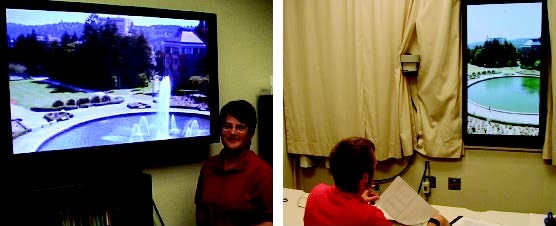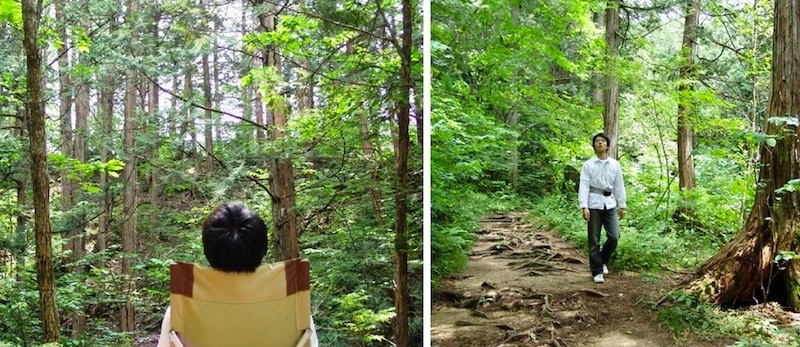Getting outside is good for our brain and body, says naturopath Dr. Alan Logan, author of Your Brain on Nature. In a modern world, our well-being might depend on embracing our ancient human “biophilia” — or love of the natural environment.
I’m hooked up to a computer with headphones like an auditory umbilical cord, staring in to the pixelated void of an LCD monitor. I’m hunched like Quasimodo over a keyboard, moving nothing but my fingertips, in a cognitive space of left-brain verbal-mathematical processing. At this moment, I’m a floating hunk of thinky frontal cortex tethered by a white earphone umbilicus and some finger tendons.
My office is dark — the one window faces a brick wall, and I’ve replaced my warm incandescent bulbs with energy-conscious fluorescents, which carry all the luminous ambiance of a late-night bus terminal bathroom.
I’m speaking to naturopath Dr. Alan Logan, the author of the forthcoming book Your Brain On Nature, about how crucial the natural environment is for human health.
The irony isn’t lost on me. Or Dr. Logan.
“Even if you have a television screen that shows a nature scene, you won’t get the same physical effect as viewing the real outdoors,” he explains. So my Mac screen saver with the sunset isn’t going to cut it?
“Not really,” he says. “It’s barely better than a blank wall.”
He describes an experiment: three groups of people with a normally windowless office were given a choice of doing mentally demanding tasks while looking at three things:
- a blank wall;
- a plasma TV with an outdoor scene; and
- a glass window that showed the same outdoor scene.
Experimental twist! The plasma TV screen was designed to look exactly like a window, complete with drapes.
Researchers followed the workers for 16 weeks, measuring their physical, mental and emotional state. Result: A glass window was the most restorative view. When participants gazed out the window, they calmed down.
But the plasma TV scored no better than the blank wall. So much for “realistic picture quality”.
The researchers in this TV study worried about “environmental generational amnesia” that could result from younger people spending their days staring at screens instead of playing outdoors, and they described the deep human “biophilia”, or love of nature, that “is a fundamental, genetically based human need and propensity to affiliate with ‘life and lifelike processes.'”
“Ironically,” says Dr. Logan, “it’s science that’s leading the charge on behalf of nature.”

Our ancient selves
But why is nature so important to us? Well, most importantly, we’re 21st century people living in ancient bodies.
“Let’s contextualize this in ancestral health,” explains Dr. Logan. “We’ve come from hunter-gatherers.
“My entire message in the book involves thinking about where we’ve come from. The genus Homo has been around for 2 million years. For 2 million years, our genus learned how to sustain itself in nature. We learned how to seek out environments in our best interest, within nature. Where is water? Where are fruits and berries?
“It seems plausible that we’d be drawn to certain locations and niches that sustain human health. That applies to our nutritional intake, our physical activity, and where we conducted that physical activity. We had to walk or run to sustain ourselves. The reward was survival.”
Our bodies, brains, and feelings are all wired for natural cycles, sights, sounds, and spaces.
Fear and loathing
And this wiring runs deep, down into the core of our brain. Natural environments activate the anterior cingulate and the insula, two parts of the brain associated with emotional stability and wellbeing, as well as awareness of self and a “bridge” between sensation and thinking. On the other hand, modern urban environments activate the primal fear circuits.
“What finally pushed me to write about this subject in 2010,” recalls Dr. Logan, “was functional MRI research [a “live action” brain scan that can show which parts of the brain are active during a given task] showing that brain firing really diverged depending on what people were seeing, even if these images were coming at them rapid-fire before they had time to contemplate.”
Scenes of vegetation and nature were processed as soothing and pleasant; scenes of urban imagery — “the purely built environment”, says Dr. Logan — were processed as potentially stressful.
It doesn’t stop there, he argues. “We also learned through our evolution that nature can kill, maim, sting, and bite us.” Even infants naturally fear creepy crawlies, even though they’ve never seen a spider or snake. Something in our brain knows what is scary or potentially harmful, and activates the defense mechanisms.
The knowledge-society challenge
Dr. Logan’s followed the research in this area for many years — one of his earlier books is The Brain Diet: The Connection Between Nutrition, Mental Health, and Intelligence.
“I think this basic stress response has tremendous relevance for knowledge workers,” argues Dr. Logan. We’re surrounded by sensory cues and stresses that require our brains to constantly function on high alert.
“We live in a distracted world. The challenge for knowledge workers is to stay on point and avoid all the distractions that surround us — whether it’s an email that we decided to open — then it takes us 24 minutes to get back on task again — or whether it’s distractors on a screen, or driving in traffic, whatever. This is the age of distraction.
“We’re swimming in a sea of fast-moving information. It takes a tremendous toll on the brain, having to go through your day having to filter out distractions. The idea of ‘multitasking’ is nonsense. It’s not supported by the fMRI studies. Multitasking creates stress.
“The fallout from that is an incredible cognitive fatigue. We’re expending a tremendous amount of effort and energy having to inhibit our natural responses.”
If you’ve struggled to find “willpower” to exercise or stay on a nutrition plan, this won’t come as a surprise.
You know the mental exhaustion of having to constantly inhibit your natural urges in a modern world whose routines, cues, and structures practically frog-march us into sloth and gluttony. By the evening of a stressy day at work, or by the second week of a dreary early-morning gym routine that involves forcing yourself to tread monotonously on a mill, you’re ready to quit.
It makes perfect sense, proposes Dr. Logan. “Trying to do things while also inhibiting natural responses, or filtering out competing stimuli, is like driving with one foot on the accelerator and one foot on the brake.”
“I’m not anti-technology,” he claims, “but we really need to think as a society how omnipresent our screen is. And stress is a massive contributor to eating so-called comfort foods. We don’t reach for broccoli and kale when we’re under stress.”
The nature cure
There’s a term in Japanese — shirin-yoku — that translates as “bathing in the forest air”. Spending time in natural surroundings, such as a forest, influences a wide range of stress markers and physiology. Stress hormones and heart rate go down, immune systems and mood improve. Researchers from one study concluded that “shirin-yoku can effectively relax both people’s body and spirit.”
Dr. Logan concurs. “No matter what the stress, nature can undo it.”
Not surprisingly for a region whose traditional architecture seamlessly blends indoor and outdoor spaces, scientists in Japan are leading the research charge. But North Americans are picking it up. The science is accumulating like fat fluffy snowflakes.
For instance, researchers at Carlton University in Ottawa, a city gripped in winter’s clutches for six months out of a year, compared walking outdoors through green spaces with walking through weatherproof underground tunnels. While walkers underground were spared the season’s whims, walkers outside felt — and performed — better in terms of their mood and thinking.
“People do say they feel better in nature,” says Dr. Logan. “These studies just confirm what we already knew.”

Your exercise, on nature
Sometimes, it’s just hard to get into the mood to exercise. And sometimes, even once we get going, we’re not really feeling the mojo. Dr. Logan understands.
“Motivation is undoubtedly the biggest stumbling block to exercise, whether you’re trying to build or maintain lean body mass, or trying to lose fat. It’s the negative aspect that is the stumbling block. You notice pain. You notice fatigue. You get into the mindset of these barriers to exercise.”
But in contrast, he says, “green exercise” — i.e. exercise outdoors, in natural spaces, creates and maintains motivation. “It elevates your mood and you’re effectively ‘out of your head’.”
Not only that, exercise in natural surroundings can improve performance. One early study compared novice runners on a wooded running path versus a plain open track. Runners were simply asked to run at any pace they chose. Runners in the woods ran faster.
“In the wooded environment, the runners felt better. They felt they were ‘outside of themselves’. They didn’t have the perceptions of fatigue and pain. They weren’t thinking about their side stitch. Sure enough, the runners in the woods ran better. Their finish times were much faster than the runners on the open track.”
When re-tested for runners on a treadmill, the results were the same. “People just run faster outdoors.”
How to go au naturel
It doesn’t take much to reap the benefits of “your brain on nature”, says Dr. Logan. “Stepping out of your normal situation for as little as 20 minutes in nature dramatically elevates your mental outlook, and lowers your perceptions of stress. That alone is enough to improve your cognition and focus, and increase your creativity.
“Time spent in nature allows a break from inhibition. The very act of being in nature, in green space, is cognitively restorative, simply because you aren’t applying the brakes any more.”
Here are some tips from Dr. Logan about how to improve your nutrition, exercise, and overall wellness by putting your brain on a nature diet.
- Get outside, whenever and wherever you can. Even small doses of nature help. Heck, even sitting next to a plant is an improvement.
- Stay present. Nature time is now-time. “Rumination about the past leads to depression, while rumination about the future leads to anxiety,” says Dr. Logan. “Being present is a gift that nature gives us.”
- Stay aware. “This is really all about mindfulness,” says Dr. Logan. “Mindfulness is the bridge between everything, whether it’s exercise benefits, better cognition, healthy eating. Staying in the here and now is the essence of mindfulness. Nature facilitates mindfulness.”
- Find your natural environment wherever possible. “It was a bit funny that researchers for the shirin-yoku studies literally had to take a high-speed train to get to the rural environments they used,” chuckles Dr. Logan. “But nevertheless, most of us can still access green space. Most of our better cities still have green space. New York has Central Park; Vancouver has Stanley Park. Find your green space.”
- Get involved and advocate for green spaces. “This research that’s emerging should indicate to all of us that we should be taking this extremely seriously,” says Dr. Logan. “It’s not a hippie message at all. As our cities expand, we need to preserve and hold on to these natural spaces. It’s a very important message for urban dwellers — maybe even more important for them, because they’re swimming in this sea of information and stimulation.” Whether it’s planting a small garden or getting active in your community in favour of bike paths and parks, see what you can do to pitch in around you and create green space.
- Pass it on. “Younger generations will not be aware of what once was. If you don’t know, you can’t appreciate the depths of it. You’ll never have a handle on what the benefits of nature could be. That’s a very dangerous place to go.” So take your kids outside with you. Go hiking, camping, and on other outdoor adventures as a family. Leave the Nintendo and laptop at home.
- Go for the real thing instead of shortcuts. “Virtual nature is nice but it really doesn’t work very well,” says Dr. Logan. “It’s the same as the 1950s or ’60s idea of exercise or a full meal in a pill.” So get outside — really get outside. And see if you can finagle a window in your office.
- Don’t wait for the “perfect time” or the “perfect place”. Be brave about the weather — remember, as the farmers say, “There’s no bad weather, only inappropriate clothing.” Outside is just a door or two away.
- Whatever you can do, do it. A 5-min walk at lunch. A bike ride to work. A hike on the weekend. Surfing. Playing catch in the park. A swim in the lake. A winter cross-country ski trip. Sitting in the backyard under a tree. Whatever you can do, just get outside. Your ancient brain and body will thank you.
Eat, move, and live… better.©
Yep, we know… the health and fitness world can sometimes be a confusing place. But it doesn’t have to be.
Let us help you make sense of it all with this free special report.
In it you’ll learn the best eating, exercise, and lifestyle strategies — unique and personal — for you.
Click here to download the special report, for free.
References
Click here to view the information sources referenced in this article.




Share